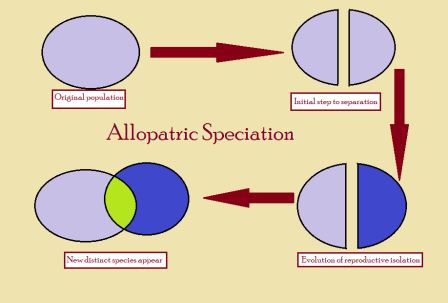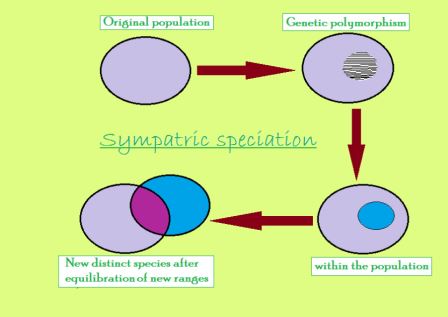Allopatric and Sympatric species / Allopatric vs Sympatric species
What are the differences and similarities between allopatric and sympatric species
Allopatric species (Allopatric speciation is the evolution of species caused by the geographic isolation of two or more populations of a species):-
-
Allopatric speciation is the type of speciation that occurs when the biological populations of a same species separated from each other to the point that helps to prevent any type of genetic interchange.
-
This type of separation is also known as Vicariance (A process which help the geographical range of an individual species, is divided into gap parts by the occurs of a geographic changes or Human activity). Allopatric and Allopatry, both are the part of the biogeography, which are mainly used for the individual animal or plant whose ranges are properly separate and they never mixed up in any common place together. If these individual living organisms are mostly related to each other, then the cause of this type of distribution is usually allopatric speciation.
-
When the allopatric speciation involves this can be the result of population dispersal leading to emigration and the geographic changes or emigration can be the result of such as shifting places of continents, and the sudden arise of mountains, separate land, islands, water bodies, and glaciers or because of the large scale human activity such as example agriculture or civil developments can also change the distribution of species populations.
For more details please see Allopatric Speciation / Geographic speciation / Vicariant speciation

Sympatric species (Sympatric speciation case held divergence is facilitated by the absence of gene flow):-
-
Sympatric speciation is the type of process by which the new species go through a evolution because of the environment from te main single ancestral species while live in or occupy the place or environment in the same geographic region.
-
Sympatric and sympatry, both are the part of the biogeography or evolutionary biology, which are mainly used for the individual animal or plant whose ranges are overlap or open even identical, so that they occur together at least in some common places. If these organisms are closely related, e.g. sister species (Sibling species), then this type of distribution may occur the result of sympatric speciation.
-
For the multicellular eukaryotic organisms, sympatric speciation is an uncommon but plausible process by which genetic divergence of various populations a single parent species’ various populations and lives in or occupies the place or environment in the same geographic region needs to the creation of new species. In bacteria(prokaryotic microorganisms), the same type of process are more common because bacteria are less effected by the homogenizing effects of sexual reproduction from to comparatively dramatic and rapid genetic change through horizontal gene transform.

- 1075 reads
